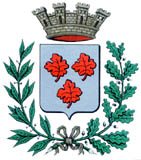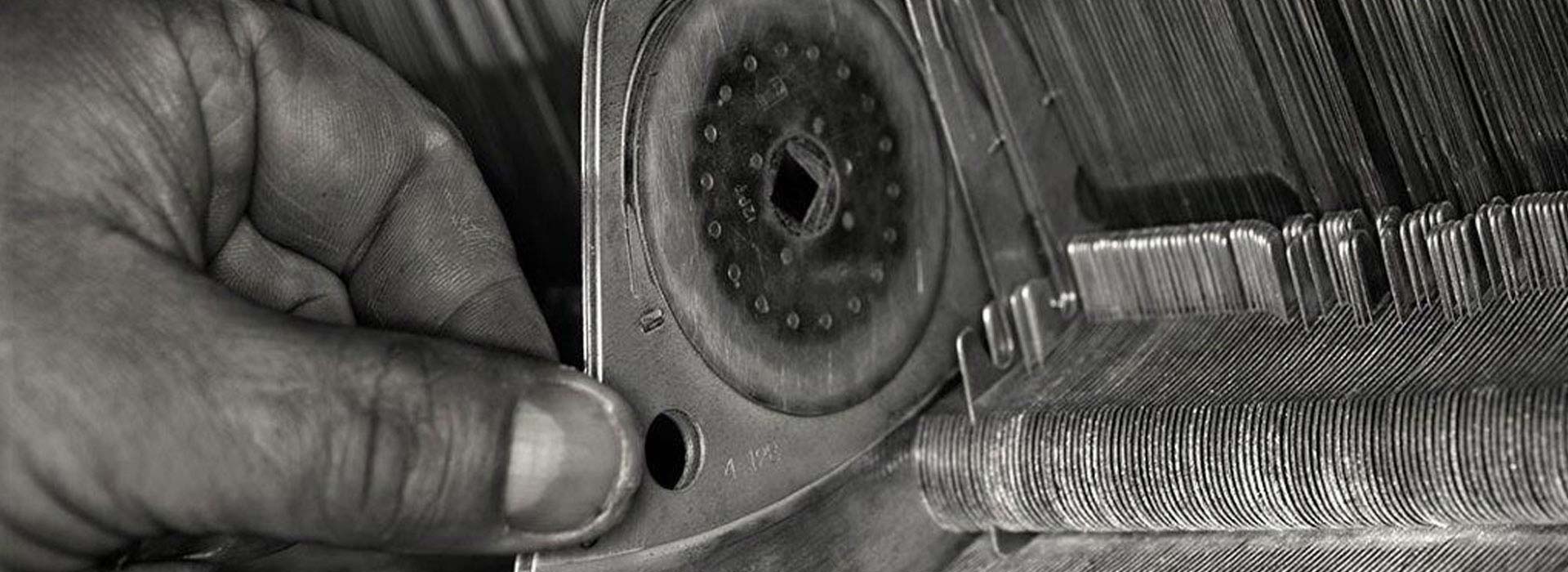

History of Caudry
Origins
From the origins to the end of the XVIIIth century
Caudry' name origins
The town of Caudry did not always bear its current name. However this last derives from preceding names of the city :- Calderiacum in 1087
- Caudris in 1129,
- Cauderi n 1219,
- Caudri en Borneville,
- Caudri in 1286,
- Caudry in 1349.
Armorial bearings of the city
Caudry and its lords
From the Middle Ages until the Revolution, many lords reigned on the caudresian territory among which :
- Almaric de Caudry (1007)
- Amulric de Caudry (1078)
- Mathieu de Caudry (1140)
- Alondus de Fontaines, Régnier de Beaumont, Adam de Caudry (1150)
- Nicolas de Caudry, l'un des six pairs de Valenciennes (1184)
- Adam de Caudry, vassal d'Adam de Walincourt (1207)
- Lambert de Caudry, époux d'Agnès de Héripont (1219)
- Gérard de Saint-Aubert, Régnier de Beaumont (1220)
- Alulphus de Caudry, Chevalier (1223)
- Adam de Caudry (1227)
- Jean Flamen, Seigneur de Caudry et de la Sotière (1233)
- Adam de Caudry (1239)
- Jean, Seigneur de Caudry dit "de l'aitre" (1241)
- Adam, Chevalier, Seigneur de Caudry (1249)
- Mathieu de Caudry (1272)
- Adam, Sire de Caudry (1278)
- Jean de Brebière, Seigneur de Caudry car ayant épousé Alys, fille d'Adam de Caudry (1315)
- Jacques de Haspres, Seigneur de Caudry car ayant épousé Marie, autre fille d'Adam de Caudry (1322)
- Adam Flament, Seigneur de Caudry (1347)
- Adam, dit Flament, Seigneur de Caudry, bailli du Cambrésis (1360)
- Pierre de Caudry (décédé en 1424)
- Guillaume de Viefville, Seigneur de Romeries et de Caudry (1530)
- Pierre de Viefville, Seigneur de Caudry (1570)
- Charles de Viefville, Seigneur de Caudry (1635)
- Charles de Lignières, Seigneur de Caudry (1672)
- Félix-Ignace-Guillaume de Taffin, Seigneur de Troisvilles, achète la Seigneurie de Caudry (1755)
- Charles-Augustin-Hyacinthe Cordier, achète la Seigneurie de Caudry puis celle de Potelle et de Borneville (1763). Il fut le dernier Seigneur de Caudry.
Industrial Rise
Birth of the textile
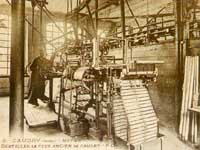
Humble village of 1926 inhabitants in 1804, nothing seemed to predispose Caudry to become one century later an industrial town of 13 000 inhabitants. Well off any significant axis of communication, Caudry is one of these cities born of industry, better, it was born from an industry, that of tulles, laces and embroideries mechanical.
Since the end of the High Middle Ages, the area of Cambrésis was famous for its "batistes" (very fine fabrics of flax). In 1789, the "mulquiniers" (weavers) worked on 13 029 weaving looms out of wood installed in all the villages of Cambrésis. However, after 1790 and the emergence of cotton, local industry was forced to reconvert itself. Tulle, initially imported by the English, quickly was leading in Valenciennes, Calais, Saint-Quentin, then in the heart of Cambrésis.
The firsts caudresian looms are installed in 1825 by Placide Gabet in the Castle of Caudry. The city launches out in the adventure. In 1827, Caudry counts 25 factories and 220 looms devoted to the production of the cotton tulle. The adaptation in 1838 of the Jacquard system to the tulle looms by Jourdan and Fergusson gives rise to lace, known as mechanical lace. Lace from now on will be produced by looms known as "leavers" ones. The first lace loom was implemented at Caudry at the beginning of the years 1840 by the Tofflin brothers. From 1850, these looms are driven by the vapor. In 1865, the first looms with point lace is installed in Caudry.
However, caudresian textile industry will undergo a significant crisis until 1880. Free trade with England, concluded by Napoleon III in 1860, will disadvantage Caudry, equipped with an old material which cannot compete with the cities equipped better like Nottingham or Calais.The development of the end of the XIXth century
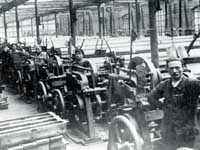
Years 1870 and 1871 will be remembered, like everywhere in France, by the war against Prussia. The Prussians enter Caudry on January 21st, 1871 and impose, in addition to the requisitions, a contribution of war, advanced by various rich persons of the town. The armistice was signed on January 28th, 1871 in Versailles and the Prussians were not long in leaving Cambrésis.
The end of the XIXth century is marked by the port of mechanical lace in the female costume, through all the social classes. This phenomenon, as of significant appropriations granted by the Debail bank, make it possible to the craftsmen to acquire a modern material. From 1880 to 1900, factories are built and looms are delivered daily in Caudry. The lace of Caudry is exported everywhere and the purchasers of the whole world are coming in the city at the time of the seasonal fairs.
At the same time, Caudry is interested in the mechanical embroidery. The embroidery was introduced into the city by Gabet-Carpentier and Tilmant in 1893 and the first embroidery looms with Jacquard is installed by Fernand Beauvillain in 1906. Thus, until 1914, and in spite of serious social conflicts, Caudry knows one era of exceptional prosperity.
Before the war, the city counts 600 "leavers" lace looms for 177 manufacturers, 550 tulle looms, 30 point lace looms and 630 looms for the embroidery. The population reaches on 13 390 inhabitants.The first World War
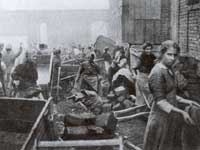
Following the assassination of the archduke of Autiche in Sarajevo on June 28th, 1914 and with the tensions through Europe, the governments prepare with the conflict. In Caudry, german lace commission agents Heymann and Alexander leave the city on July 20. The order of general mobilization is posted in Town hall on July 28th. August 25th flow of the tired troops newcomer of Belgium. In the evening, a German plane is cut down over Caudry. The day of the 26th is marked by a rain of German shells on the city : the inhabitants pack themselves in the basements while hundreds of houses were destroyed.
The 27th, at the first hours of the morning, Caudry is invaded. The Germans plunder and destroy systematically the trades, the drawings, papers... Five civil victims are added to the soldiers killed on the battle field. Wounded people are transported in infirmaries street Victor Hugo and street of Saint Quentin. And while the war and the combat continue further, starts for Caudry a long period of occupation which lasts until 1918. Kommandantur settles in Caudry on December 24th, 1914 and the life of Caudresians is thus regulated by the German administration.
Some Caudresians are employed with the construction of quarters for the german military hospital, occupying the factory of Transvaal. The Germans also proceed to arrests and taking of hostages among the population, putting these Caudresians in prison then off-setting them in Germany. The Mayor, Ernest Plet, implied in a business of clandestine transport of mail, is put under arrest. Relieved of its functions in March 1916, he is off-set. The textile manufacturies not having been destroyed are requisitioned to the needs of the occupant, while the copper and the steel of the looms are sent in Germany to manufacture weapons and ammunition.
Since the autumn 1917 and the arrival of the Americans in Europe, the war changes. The massive and prolonged attacks are multiplying and the English and French planes furrow the sky. The order of evacuation is given by Kommandantur of Caudry on September 30th, 1918. Approximately 2 500 people will remain downtown whereas 10 000 Caudresians begin a long tour until Binche, in Belgium. October 10, 1918, the English of the 37th division penetrate in Caudry and put an end to four years of occupation. After the armistice, Caudresians return to the country. However, 200 civil died during the exodus and 450 soldiers will not return from the battle fields. To honour their memory, a war memorial was inaugurated on the place on October 1st, 1922.Industrial Modernization
After the First World War, the majority of the caudresian manufacturers used the war damagees to modernize their production equipment. Caudry then chooses lace in great width and the top-of-the-range one, like the creations for the houses of "Haute Couture".
With one year of delay, the lace manufacturers of Caudry are touched by the crash of Wall Street. Since 1931, the situation is catastrophic and unemployment is almost complete. This situation perdure until 1937 but the war, as in 1914, slows down the recovery. Despite of the German occupation, the first tulle nylon is produced by the caudresian looms in 1943.The second World War
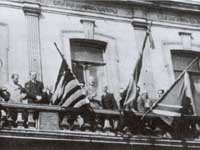
The second world war, started in 1939 in the east of Europe, will touch France on May 10th, 1940 when the German army crosses Belgium and that the "Battle of France" begins. Friday May 17th, 1940, many Caudresians had taken the way of the exodus. Some never returned. May 18th, German tanks enter Caudry and draw from the shells perforating on the Town hall, killing 6 people. The occupation began and Kommandantur was installed street Salengro. Caudresians were going to undergo rationing while resistance was going to be organized in Caudry.
In spring 1942, a group formed of Gaston Dassonvile (former officer of war 1914/18), Lucien Jansssoone, Victor Cordonnier, André Mailliez, Léonce Bajart, Henriette Balési (alias Mrs Blanche) and Alfred Mélayers gets along with Paul Tavernier, interprets at Kommandantur. They collect abundant information on the enemy, get of the assistance to refractories and organize the passage of the allied aviators fallen into the area. Other groups are formed and multiplied sabotages.
During the summer of 1944, German convoys crossed the city, badgered by allied aviation and local resistance. September 3rd, the tanks of the 5th American armoured division finally entered in Caudry.The Contemporary Time
The modernization of the textile
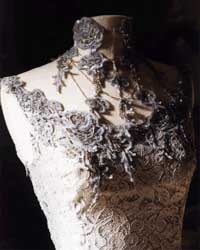
After the release, the manufacturers and the workmen assimilate the new technology of the matters and to use all the top textiles like the fibrane, rayonne, nylon, lurex... Lace is declined thus in black and white, quadrichromy and in abstracted, decorative and various drawings. It is a success and the order books are full until 1956, date on which the countries of America take protectionists measure. In the same way, the suppression of the obligation of the port of the mantille by the pope Jean XXIII during the religious offices is cruelly felt by the profession. 100 looms manufacturing the mantille stop soon. The crisis will extend until 1976.
During these 30 last years, improvements were made on the looms : computerization of the "leavers" lace drawing, automatic drilling of the Jacquard paperboards. In the same way, beside "leavers" lace, a low-of-range lace known as rachel, textronic or Jacquard tronic was developped. Today, Caudry produced under the label "lace of Calais" a lace of quality intended for the most prestigious houses of "Haute Couture". The most famous ones, like Yves Saint Laurent, Chanel, Christian Lacroix, Karl Lagerfeld or Lolita Lempicka could not resist the desire for using the lace of Caudry. Daughter of textile industry, Caudry thus obtained in 1995 the label "City and Trades of Art".Industrial Diversification
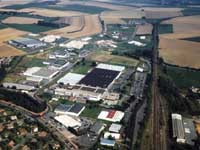
If textile industry and, in particular, lace remain the base of caudresian industry with ten companies which export more than 80% of a refined product, the economic advancement rests from now on on the diversification of the activities.
Indeed, when certain breathlessness of the textile sector was noted about 1960, the elected officials of the time, while maintaining the traditional sectors, decided to diversify their actions and to offer to the possible investors conditions of optimum reception. From this resolution was born the first industrial park from 20 hectares which accomodated since 1970 the SICOS (Industrial Company of Cosmetics). This company played the role of engine immediately. And beside small caudresian units which did not hesitate to transfer their activity, were gradually established industrial great names such Spac Nestle.Mayrs of Caudry
Since 1945 :
- Maurice Lefebvre : 1945-1947
- Albert Dhélin : 1947-1965
- Henri Lefebvre : 1965-1983
- Paul Moreau : 1983-1989
- Jacques Warin : 1989-1995
- Guy Bricout : 1995-....
Historical Sources
The historical information of these pages comes from :
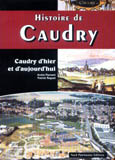 "Histoire de Caudry"
"Histoire de Caudry"
Written by André FLAMENT and Patrick RAGUET.
Caudry d'hier et d'aujourd'hui).
Published at Nord Patrimoine Editions.



